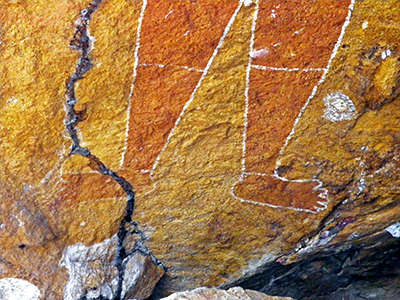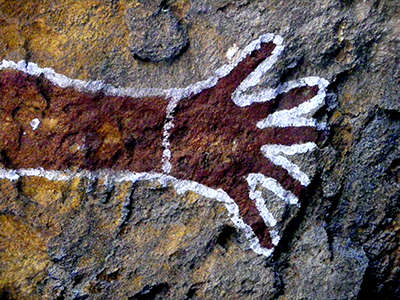Back to Don's Maps
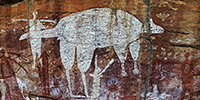 Back to Australian rock art and other Oz sites
Back to Australian rock art and other Oz sites Quinkan Corner, the Rock Wallaby Gallery, and Tent Shelter Gallery - Aboriginal Rock Art sites in Northern Queensland
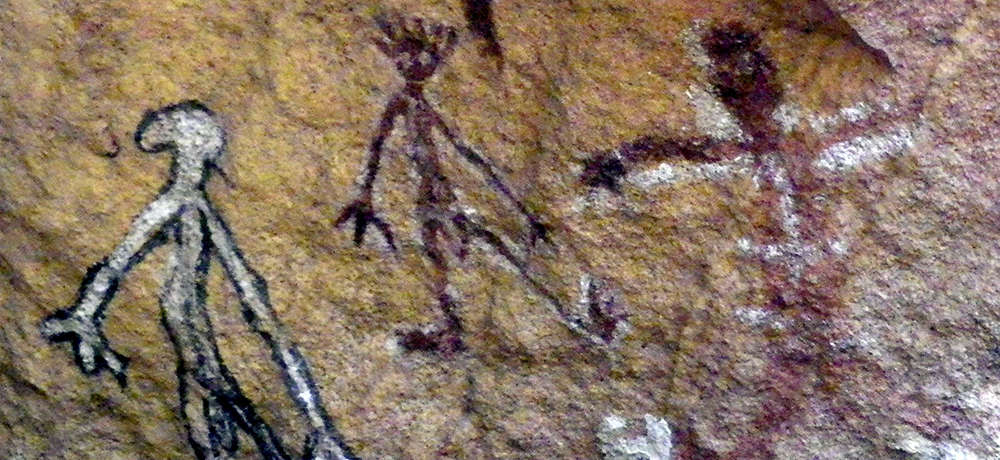
Quinkan figure on the left, and a spirit figure with lines drawn from the head at the centre, both drawn as males.
Photo: © Leo Dubal
The excellent photographs from Tent Shelter Aboriginal Rock Art site on this page are from Leo Dubal, www.archaeometry.org
Quinkan Corner
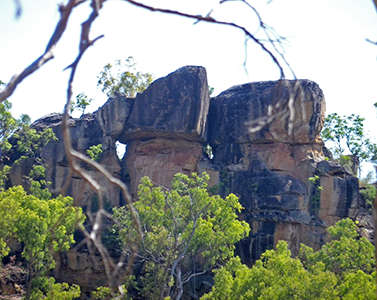
View from Quinkan corner.
Photo: © Leo Dubal
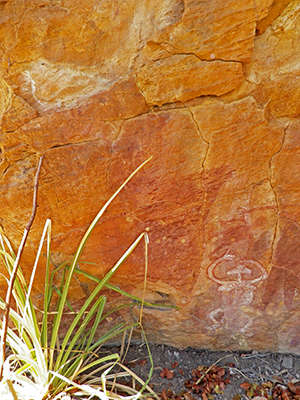
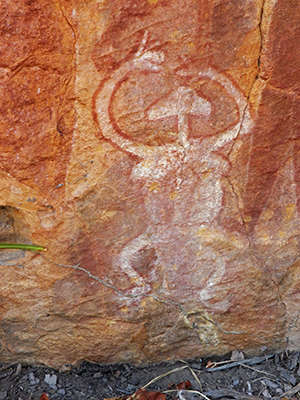
Quinkan image at Quinkan corner.
Photo: © Leo Dubal
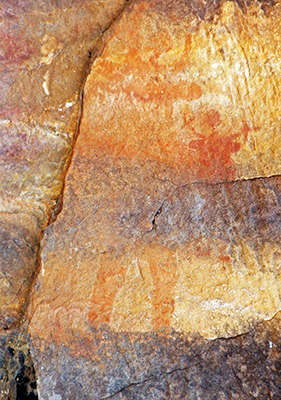

Two female figures. The female figure on the right, shown, has hands that have only three fingers. It is unknown what the significance of this is.
Photo: © Leo Dubal
Rock Wallaby Gallery
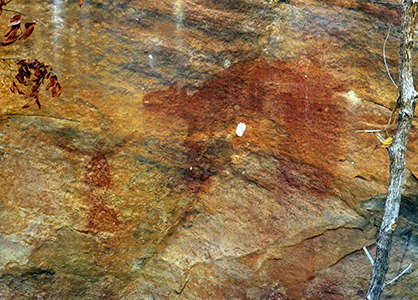
Male figure on the left, with a kangaroo, or perhaps the eponymous rock wallaby, on the right.
Photo: © Leo Dubal

This panel, to the right of the above, appears to show a platypus in a vertical orientation.
Photo: © Leo Dubal

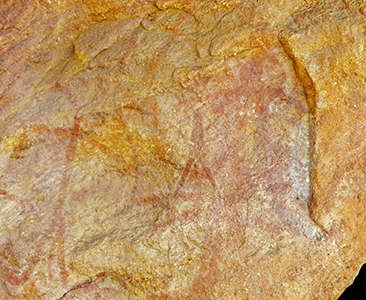
These are strange stick figures, not apparently of normal humans. Two of them appear to have feet which curve upwards, one with the foot dividing into three.
In the right hand image, on the right, is a figure with what looks like an abnormally large head.
Photo: © Leo Dubal
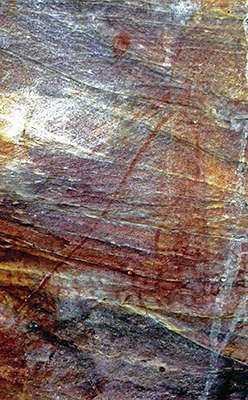
Outline in red ochre of an enigmatic figure.
Photo: © Leo Dubal
Tent Shelter Gallery
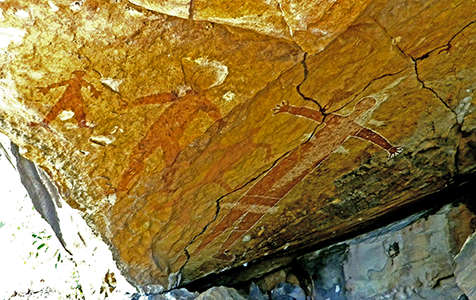
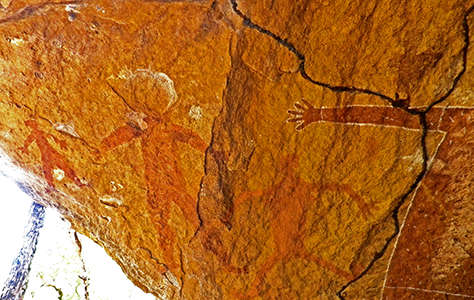
Roof of a shelter showing four figures.
Left to right, a small figure with just three fat fingers shown, a larger one with four fingers, with the head destroyed by the fall of a flake of stone from the roof, a spirit figure with twisted arms and legs, but five fingers on at least one hand, all completed in just red ochre.
On the right, a conventional figure outlined in white, infilled in red ochre. It is interesting that the figure is subdivided into segments by white lines which mark off the hands, arms, lower legs, and possibly the lower legs and feet.
There are white spots added all over the figure, to the torso, the legs, and the arms.
There may be two eyes shown by very small white dots.
Photo: © Leo Dubal
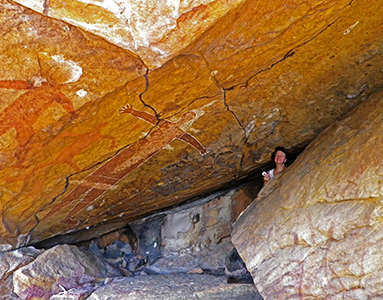
This view shows that on the right hand part of the shelter are some stick figures and other signs completed in red ochre.
Photo: © Leo Dubal
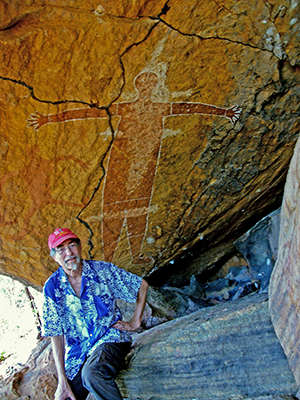
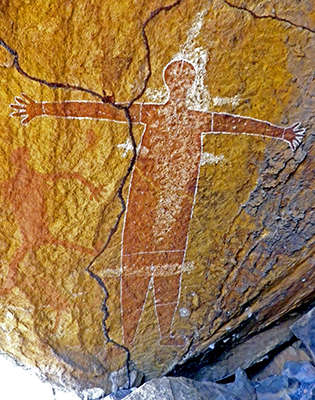
Other views of the main figure.
Photo: © Leo Dubal
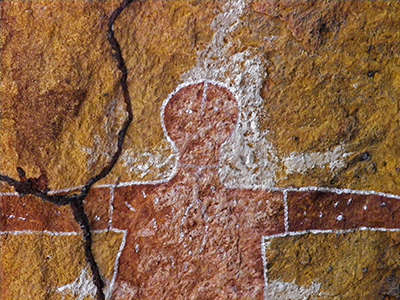
In these close ups we can see that the artist has quite deliberately divided up the painting, after infilling with red ochre, with white ochre which shows a line at the level of the calves and at the wrists, ankles and shoulders of the large figure
Photo: © Leo Dubal
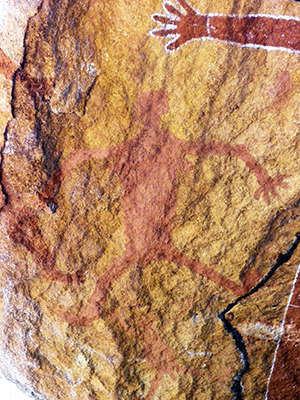
This may be a female spirit figure, with bent arms and legs, completed in a pale red ochre, with no white ochre outlining the shape.
Photo: © Leo Dubal

Complete panel, stitched from two photographs.
On the left is a hand stencil, with a red human figure to the right and above it.
Below the red human figure is a darker red male with feet shaped like those of an emu.
Above these two is a male figure with the fat fingers common in this panel.
In the centre of the image is a dark red female figure with pendant breasts and emu feet. On the right is a human figure with a hand visible having four thick fingers.
Underlying all the artwork is an older work in faded white, which may be a quinkan figure, but with the long body of a crocodile.
Photo: © Leo Dubal
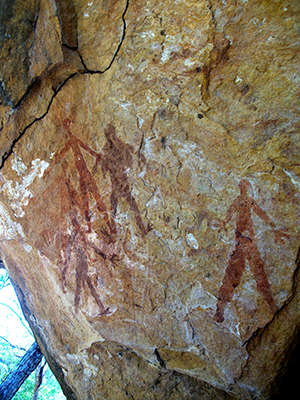
The complete panel from a different perspective, showing its place in the landscape.
Photo: © Leo Dubal
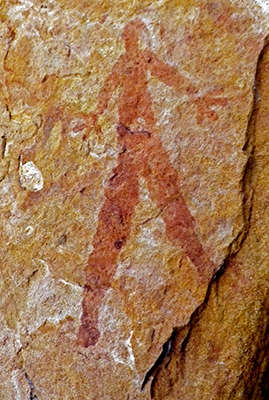
Although this figure has rather long legs, it has close to natural proportions of the body. It has what may be a topknot of hair falling to one side of the head. The feet are just lumps, and the hands are non-existent, with just four fat fingers starting from the wrist.
To the left of the figure is what may be a negative 'handprint' of an emu foot.
Photo: © Leo Dubal
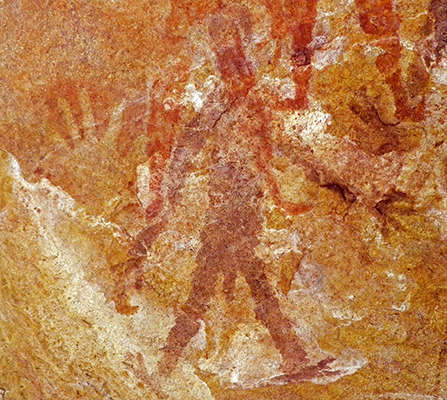
There is a (left-hand) hand stencil on the left of this panel, with a male figure in dark red ochre in the centre.
This figure has been painted with feet similar to an emu, and may be an emu spirit figure.
Photo: © Leo Dubal
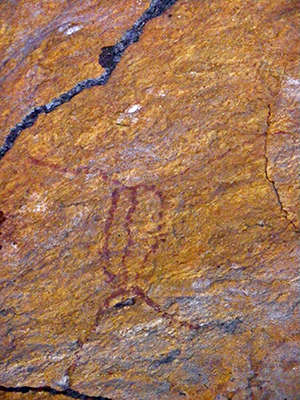
An enigmatic figure painted in dark red ochre.
Photo: © Leo Dubal
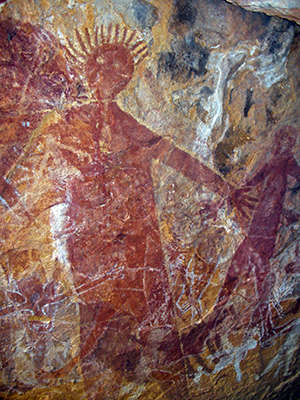
The main figure here is a spirit figure, with lines radiating from the head, similar in some ways to the Wandjina figures of the Kimberley. This figure, however, lacks the detail of the face of the Wandjina figures, and the band which surrounds the head from which the lines radiate. Pale yellow ochre has been used to outline the figure, and it is entirely infilled with red ochre.
The only facial details are an indication of eyes using yellowish ochre, and what may be a mouth.
Since no breasts are drawn, we can assume that the figure is either male or sexless, and it is outlined in pale yellow ochre. This ochre has been used to completely outline the head, giving the impression of a line across the neck. There is a line of light ochre drawn across the left arm, and what looks remarkably like a modern western necktie drawn in yellow ochre.
Note the excellent proportions of the left hand of the figure, which has been carefully drawn.
Photo: © Leo Dubal
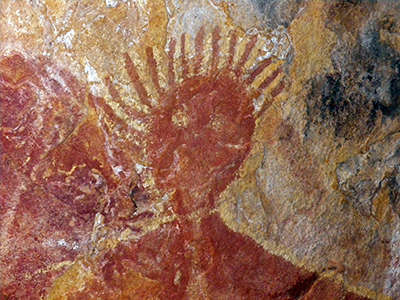
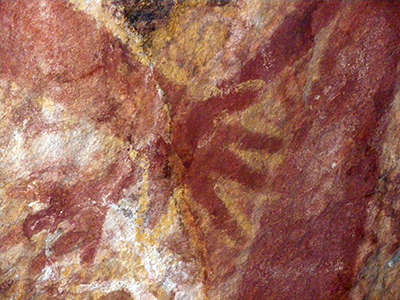
Closeup of the head of the spirit figure above, and the well drawn hand.
Photo: © Leo Dubal
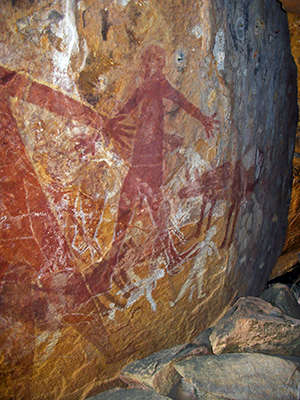
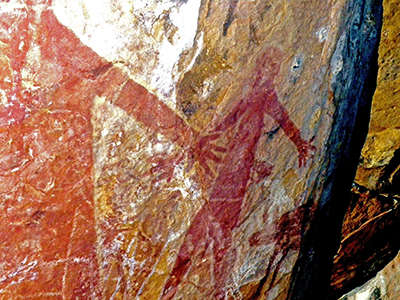
This figure is to the right of the figure above, and has been infilled in a pinkish colour, which appears in a more saturated hue than reality in the right hand image.
It is of an ordinary male human, outlined in a paler pink ochre, possibly red and white mixed. The feet are clearly delineated, and a light coloured band has been drawn across the waist. To the right of the figure a dingo has been drawn.
Photo: © Leo Dubal

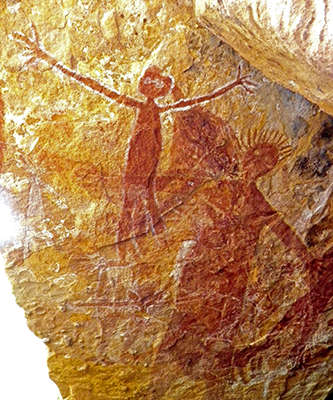
To the left of the spirit figure with lines radiating from the head, is this other spirit figure, outlined in white ochre, and infilled with red.
It appears to have an exaggerated penis, but this may be part of an overlapping figure.
The fingers on the hands are misshapen and greatly extended in length. The eyes are shown in white, and the figure is quite slender.
One foot is shown, and is very misshapen. A closeup of the foot is shown in the left hand image.
Below this spirit figure is the inverted figure of a female, referred to in more detail below.
On the far lower left of the panel is a very faded Quinkan figure in white ochre.
Photo: © Leo Dubal
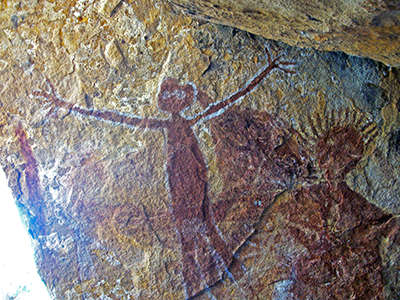
Another view of this figure.
Photo: © Leo Dubal
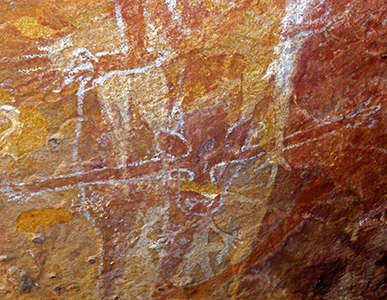
Here at the lower centre of the image can be seen what is possibly a white Quinkan figure, obscured by later paintings. It has very thin arms and outsize hands outlined in a darker colour, and what may be an erect penis.
Overlying it is an upside down female figure, more clearly seen in the inverted image below.
This female figure overlies or is overlain by the broad white thighs, thin calves and ankles, and three toed feet, of what may be two emu or kangaroo spirit figures. Note, however, that similarly shaped legs are used in this area explicitly for the legs of kangaroos.
Photo: © Leo Dubal
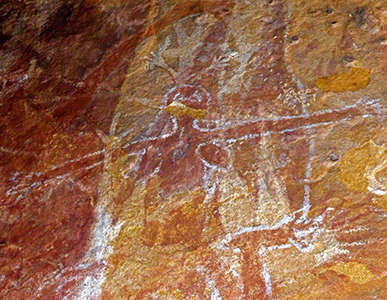
The image above rotated through 180°.
Here the female figure can be more clearly seen. The individual breasts are outlined in white and infilled in red ochre. The arms are spread wide, at right angles to the body, and the eyes are emphasised and outlined in white. The body is shown only to the level of the waist.
Photo: © Leo Dubal
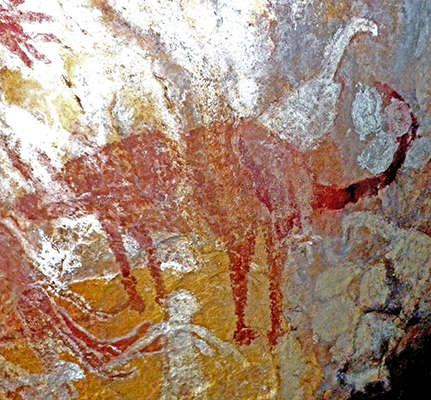
The main figure in this image is a dingo, but behind it and above the tail is a bird with a long neck and hawk-like beak, accompanied by eggs.
Below the tail of the dingo, and to the right of it is another bird with eggs.
Below the dingo is a small white human shaped figure.
Photo: © Leo Dubal
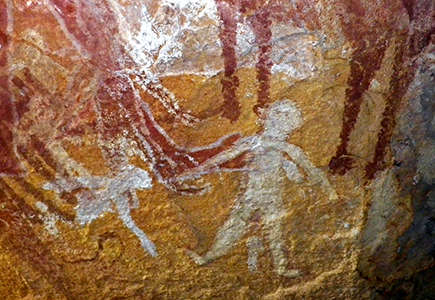
This image shows the complete white anthropomorph below the dingo. It would appear to be a female with just one breast, and what appears to be a penis, but separated from the body.
To its right is another anthropomorphic figure, indistinct in this view.
Photo: © Leo Dubal
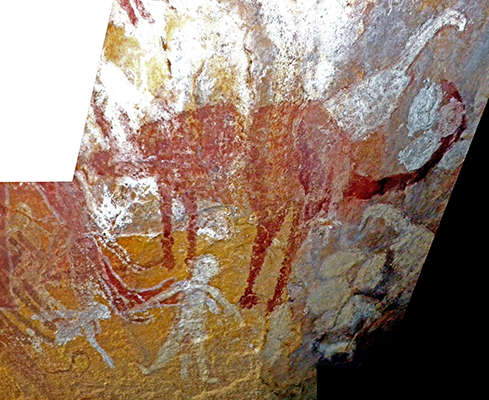
The panel after stitching together the two images above.
Photo: © Leo Dubal
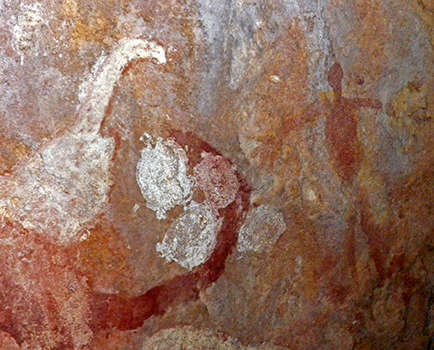
Close up of the white hawk-like bird, the eggs, and a human figure to the right.
Photo: © Leo Dubal
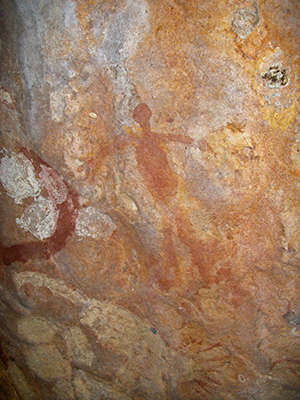
Indistinct human male to the right of the tail of the dingo, with a neck and shoulders, but with an outsize hand.
Outlined in yellow, and infilled with red ochre.
Photo: © Leo Dubal
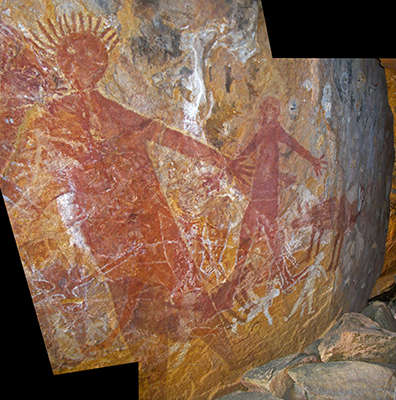
It is instructive to look at the complete panel to the right of the main figure again. This image consists of two stitched images to show most of the right side of the panel.
Here can be seen the relationships between the main figure, the pale red / pink human, the dingo, and below it the white figure of indeterminate sex. To the left of this white figure is another anthropomorph, apparently in the act of falling down.
Photo: © Leo Dubal
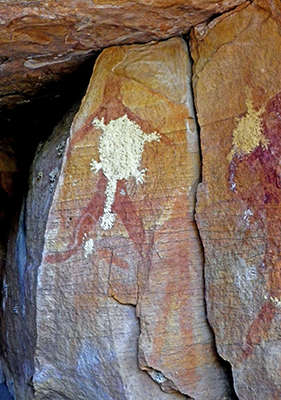
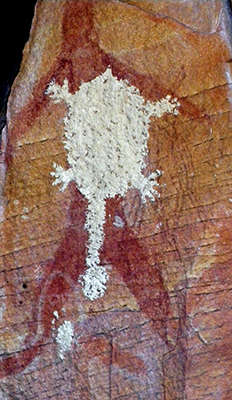
Anthropomorphic figure in red ochre, overlain with a stippled white long necked turtle.
Photo: © Leo Dubal
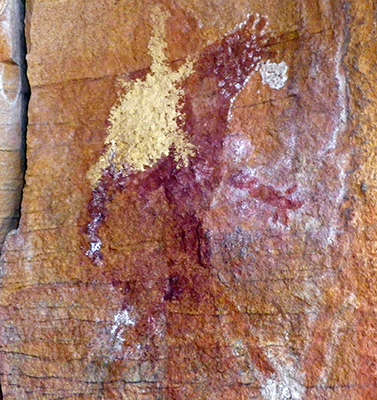
On the right of the figure above on the same panel is this yam figure overlain with a stippled cream coloured long necked turtle.
Photo: © Leo Dubal
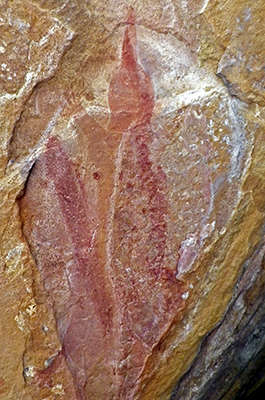
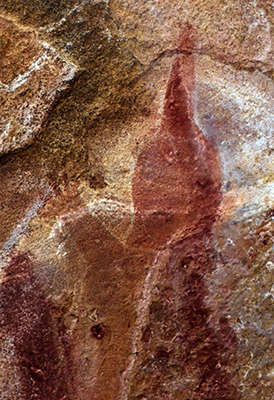
This image appears to be of a platypus.
Photo: © Leo Dubal
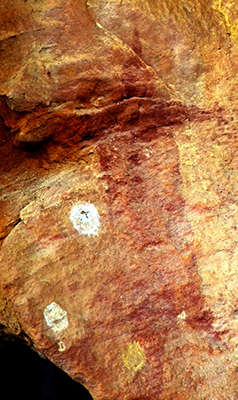
This appears to be another image of a platypus.
Photo: © Leo Dubal

Ancestor figures, shown by the vertical stripes. The one in the centre has very long toes on one foot.
A Quinkan figure appears to have been erased below this image, at the lower centre of the photograph.
Photo: © Leo Dubal
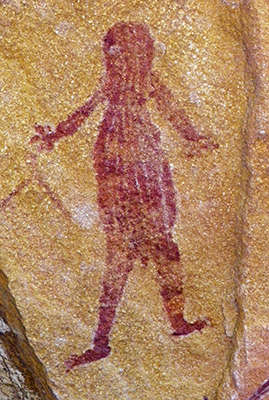
Ancestor figure.
Photo: © Leo Dubal
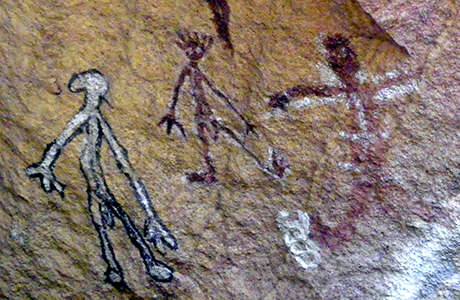
Male Quinkan figure on the left, in white and outlined in black, showing the characteristic long earlobes of these figures. In the centre is a male spirit figure with long stripes above the head, done in red ochre and outlined in white.
The figure to the right appears to have been either painted on top of a white figure, or to have been partially outlined or decorated with white ochre.
Photo: © Leo Dubal

Map of some of the sites mentioned.
Photo: supplied by Leo Dubal
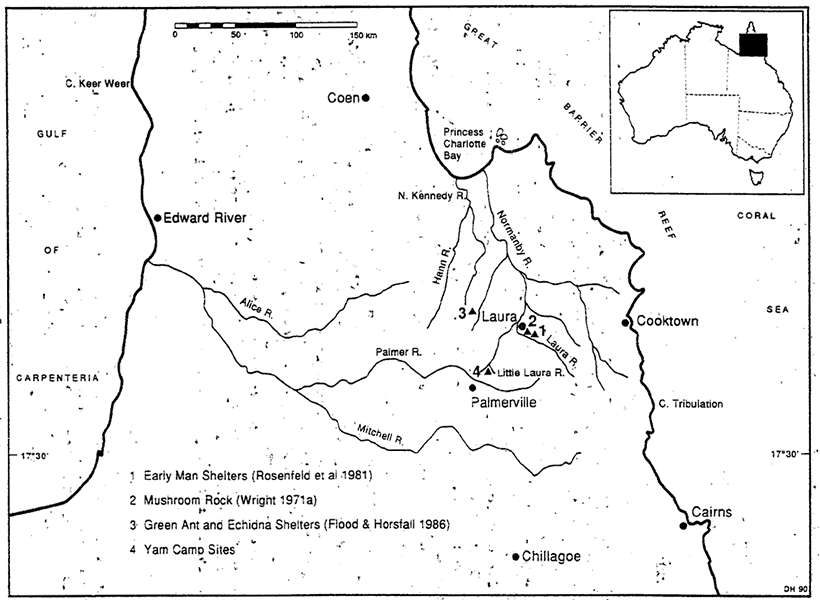
Map of part of Far North Queensland showing the location of the Laura River rock art sites.
Photo: Pearson (1989)
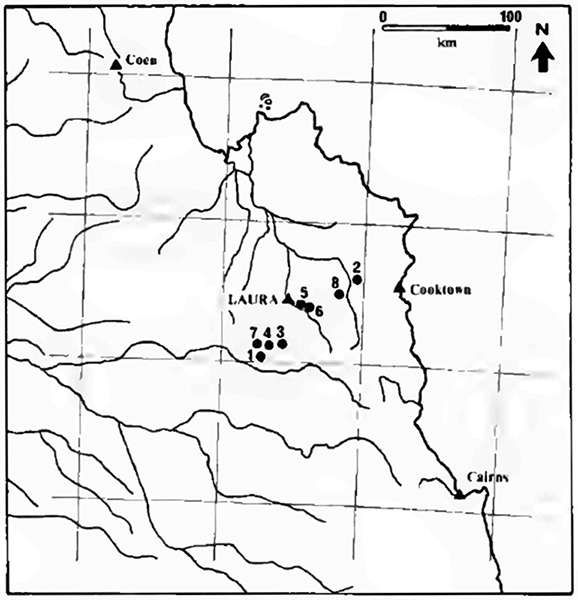
The Laura sandstone belt, showing the location
of some rock art sites.
1 Yam Camp
2 Platform Gallery
3 Magnificent Gallery
4 Sandy Creek
5 Mushroom Rock
6 Early Man
7 Red Bluff
8 Red Horse
Photo and text: David and Chant (1995)
References
- David B., Chant D., 1995: Rock art and regionalisation in north Queensland prehistory, Memoirs of the Queensland Museum, Brisbane 1 August 1995 Volume 37 Part 2 Hamlyn-Harris, Ronald; Queensland Museum
- Pearson W., 1989: A Technological Analysis of Stone Artefacts from Yam Camp Surface Scatter and Rockshelter, S.E- Cape York Peninsula, Queensland Archaeological Research, Vol. 6, December 1989
